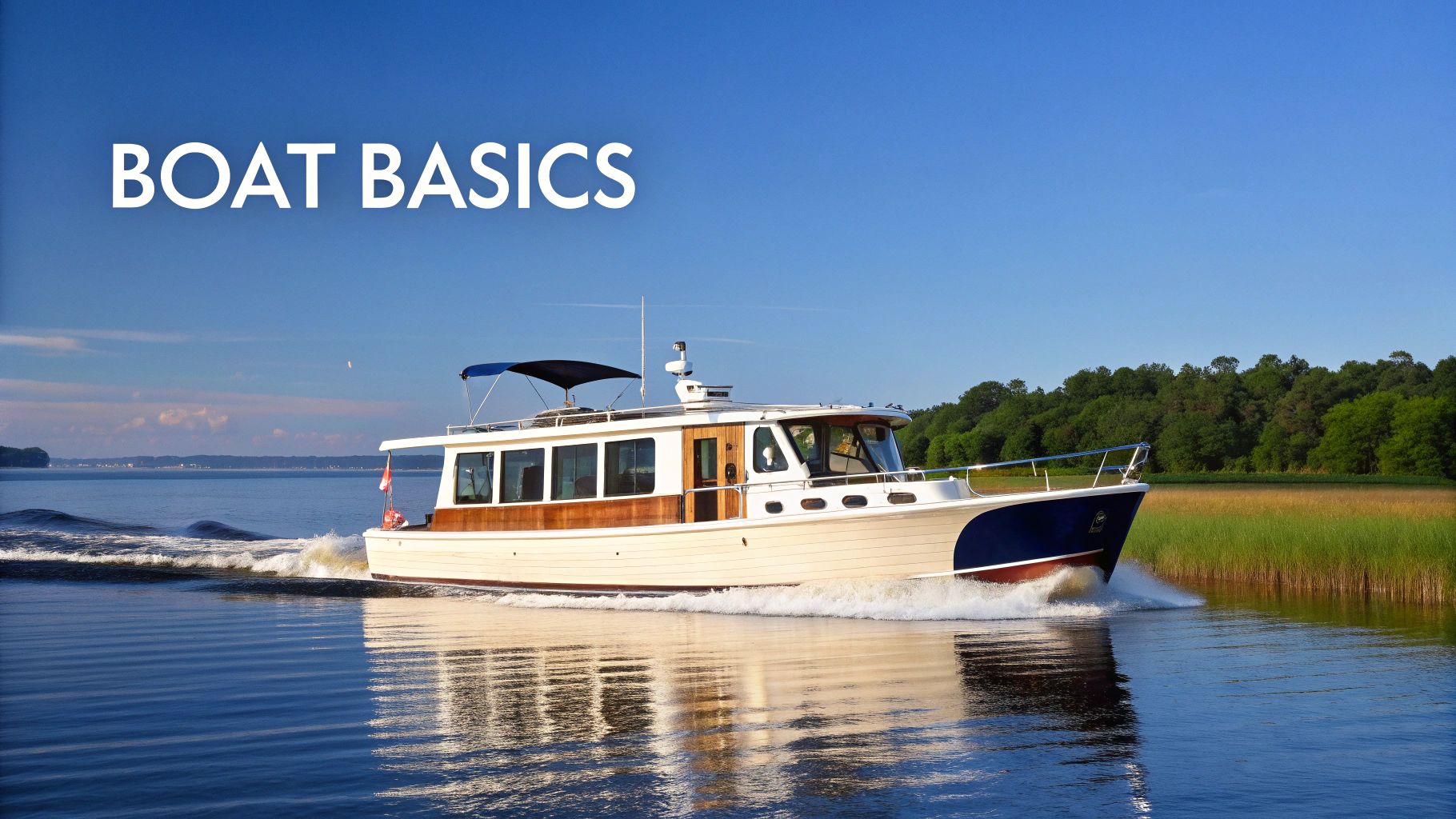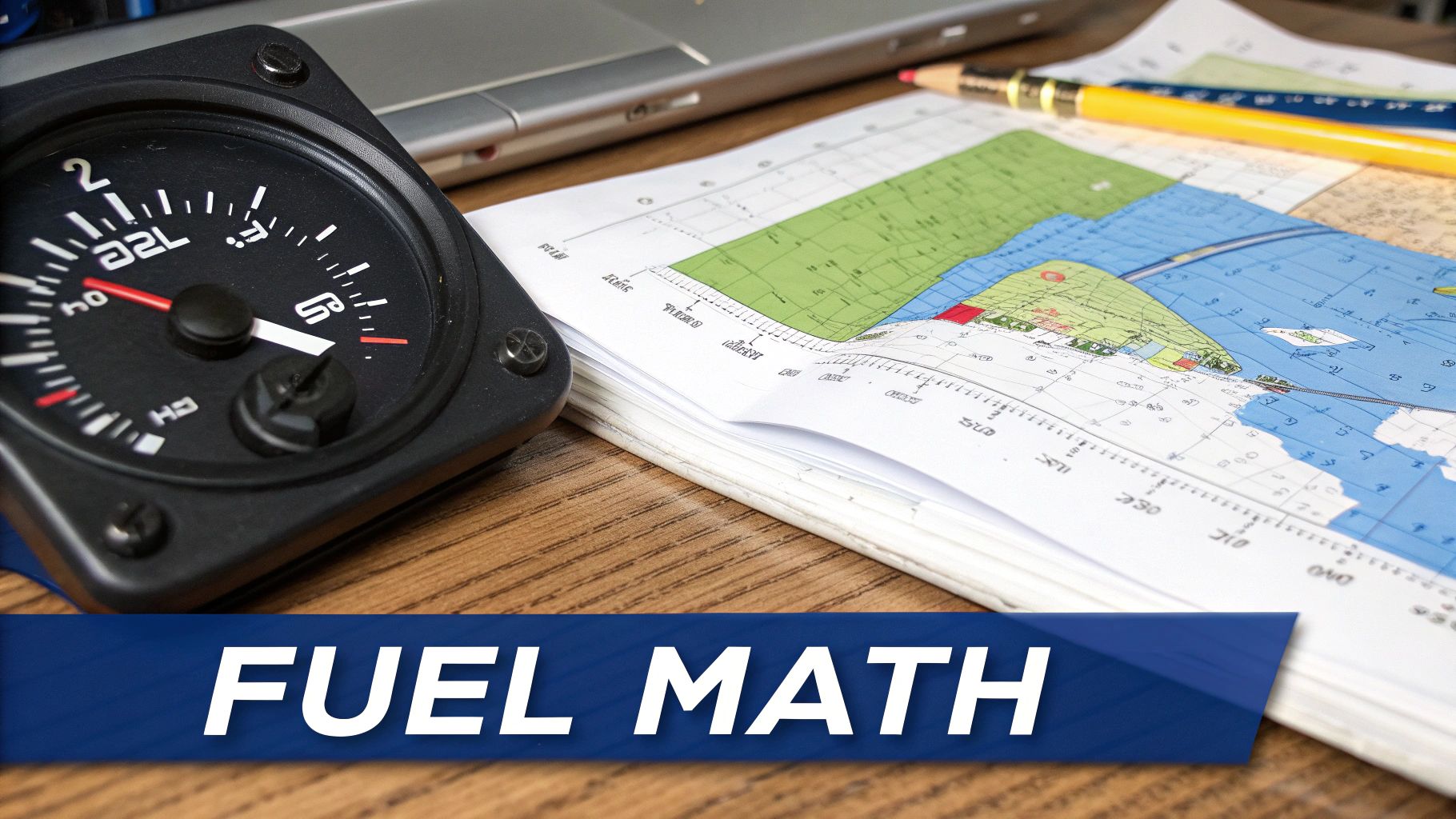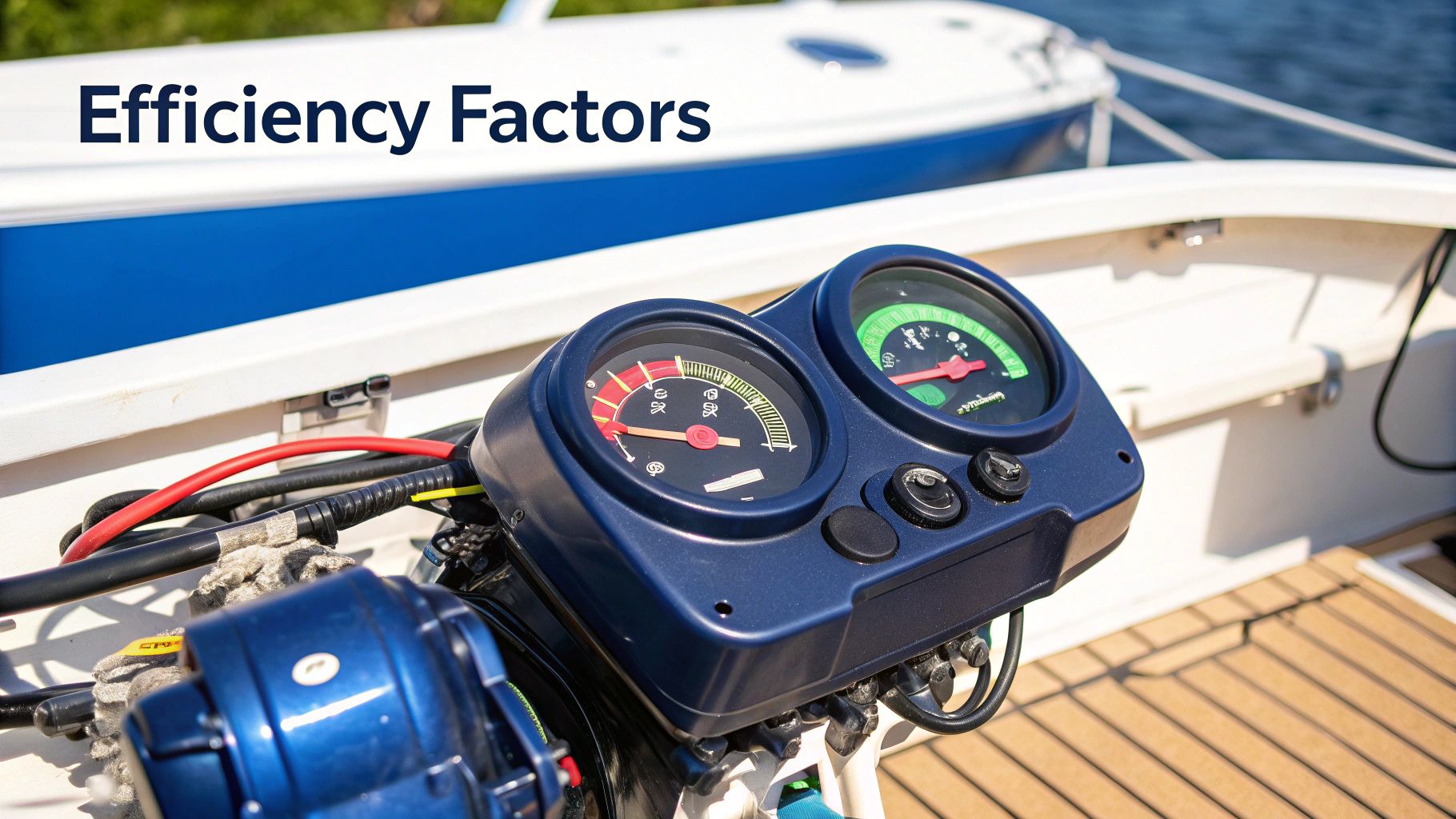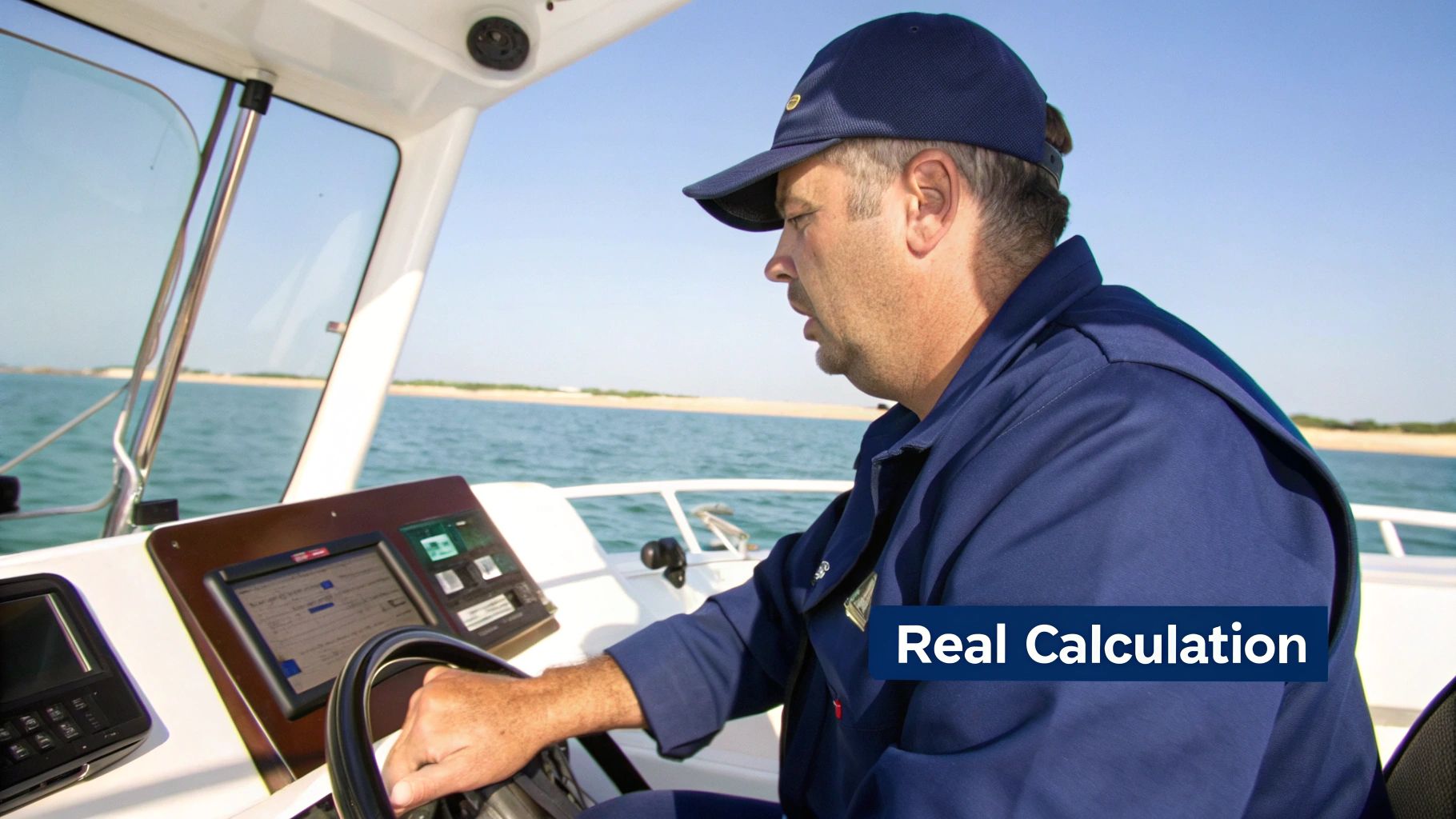Understanding the Fundamentals of Marine Fuel Efficiency

For many boaters, figuring out how much fuel they need is often an afterthought. It's easy to put it off until you're staring at a near-empty fuel gauge. But calculating boat fuel consumption is essential, not only to prevent running out of fuel but also for overall trip safety, budgeting, and environmental responsibility. It's about more than just getting from point A to point B. It's about understanding how your boat, its engine, and the environment all work together.
One of the most important aspects of marine fuel efficiency is the relationship between horsepower and fuel consumption. Even on identical boats, different engine setups can have drastically different fuel efficiency profiles.
For example, a boat with a smaller, more fuel-efficient engine may burn less fuel at slower speeds compared to a boat with a larger, more powerful engine. However, at higher speeds, the larger engine might become more efficient because it can reach its optimal RPMs faster. This shows how important it is to know your engine's "sweet spot" for the best fuel economy.
Knowing your boat's fuel consumption lets you make smart decisions about how you operate your vessel. It helps you estimate your range, ensuring you have enough fuel to get to your destination and back safely.
It also helps you budget effectively, preventing unexpected fuel costs. Plus, using fuel efficiently means fewer emissions, which reduces your impact on the marine environment.
Calculating Fuel Consumption
Calculating boat fuel consumption is key for estimating range and operational costs. The formula to estimate maximum engine fuel consumption is GPH = (specific fuel consumption x horsepower)/Fuel Specific Weight.
For example, a 300-horsepower diesel engine burns about 0.4 pounds of fuel per horsepower per hour, and diesel fuel weighs roughly 7.2 pounds per gallon. Using the formula, the fuel consumption would be GPH = (0.4 x 300)/7.2 = 16.6 gallons per hour. This calculation helps boaters plan their trips more effectively, especially when considering factors like sea conditions and engine efficiency. It's also vital for comparing different engines and planning long trips without running out of fuel. Want to delve deeper? Check out this Boat Fuel Consumption Calculator.
Why Precise Fuel Calculations Matter
Experienced mariners know the importance of accurately calculating fuel needs. They carefully track their fuel usage, developing habits that save them money and increase their operational efficiency. They also adjust their strategies based on real-time data and changing conditions.
Less experienced boaters, however, often make expensive mistakes by underestimating how much fuel they’ll need or by failing to factor in things like wind and currents. This can lead to unexpected delays, higher expenses, and even safety issues. The CLiX Fueling Solutions Blog Sitemap offers further insights on this topic. By understanding the basics of marine fuel efficiency, you can avoid these problems and enjoy a more pleasant and responsible boating experience.
Mastering the Math: Fuel Calculation Formulas That Work

Accurate fuel calculations are essential for any boater. These calculations help you predict your fuel needs, ensuring safer and more enjoyable boating trips. Understanding your boat's gallons-per-hour (GPH) consumption rate and how it changes in different conditions is key.
Calculating Gallons Per Hour (GPH)
Your boat's GPH is the basis of accurate fuel planning. It tells you how much fuel your engine burns every hour. Knowing your GPH helps you calculate your range and determine how much fuel you'll need for a specific trip. A common method for estimating GPH is: GPH = (Horsepower x Specific Fuel Consumption) / Fuel Specific Weight.
Let's say you have a 200-horsepower gasoline engine. Gasoline engines typically have a specific fuel consumption of about 0.50 pounds per horsepower-hour. Gasoline weighs roughly 6 pounds per gallon. Using the formula: GPH = (200 hp x 0.50 lbs/hp-hr) / 6 lbs/gal = 16.7 GPH. This means at maximum output, the engine burns about 16.7 gallons of fuel per hour.
Keep in mind this is just an estimate for maximum fuel burn. Your actual GPH will vary depending on factors like speed, load, and weather conditions.
Calculating Range
Once you have a good estimate of your GPH, you can calculate your boat's range. Range is the distance you can travel on one tank of fuel. The formula is: Range = (Usable Fuel Capacity / GPH) x Speed.
If your boat has a usable fuel capacity of 50 gallons, your estimated GPH is 16.7, and you plan to cruise at 20 knots, your range would be: Range = (50 gal / 16.7 GPH) x 20 knots = 59.9 nautical miles.
Always include a safety margin of at least 10-15% for unexpected situations. This means reducing your estimated range to roughly 50-54 nautical miles.
Fuel Calculation Formulas by Engine Type
While the basic principles are the same, specific formulas and factors can change depending on your engine type. The table below provides a general overview. It compares how to calculate fuel consumption for different marine engine types and provides example calculations for a 200 HP engine.
To clarify its purpose, this table outlines the specific formulas for calculating GPH for both gasoline and diesel engines. It uses a consistent horsepower (200 HP) in the examples to allow for easy comparison of the results.
| Engine Type | Formula | Example Calculation | Notes |
|---|---|---|---|
| Gasoline | GPH = (HP x 0.50) / 6 | 200 HP: (200 x 0.50) / 6 = 16.7 GPH | Specific fuel consumption can vary slightly. |
| Diesel | GPH = (HP x 0.40) / 7.2 | 200 HP: (200 x 0.40) / 7.2 = 11.1 GPH | Diesel engines generally have better fuel economy than gasoline engines. |
Key insights from the table include the different specific fuel consumption and fuel specific weight values used for gasoline and diesel engines. These differences lead to diesel engines typically having lower GPH values and thus better fuel economy.
Maintaining Accurate Logs
Keeping detailed logs of your trips can help refine your fuel calculations. Record your fuel consumption, speed, and the conditions you experience. This data will offer valuable insights into your boat's performance. You can then make even more accurate predictions for future trips.
By mastering fuel calculation techniques, you'll save money, improve safety, and gain a deeper understanding of your boat’s efficiency.
How Hull Designs Dramatically Impact Your Fuel Budget

The shape of your boat's hull significantly impacts your fuel consumption. Different hull designs interact with the water differently, affecting resistance and, as a result, efficiency. Many boaters overlook this connection, but understanding it can significantly affect your boating budget.
Understanding Hull Types and Their Impact
Three main hull types exist: displacement, planing, and semi-displacement. Each has characteristics affecting speed and fuel efficiency. A displacement hull pushes water aside, similar to a barge. These are typically more efficient at lower speeds. However, they have a "hull speed," beyond which fuel consumption drastically increases.
A planing hull, on the other hand, is designed to rise and skim across the surface at higher speeds. Less efficient at slower speeds, planing hulls become more fuel-efficient once "on plane." The reduced water contact decreases drag.
A semi-displacement hull combines features of both. It operates efficiently across a wider speed range, compromising between low-speed stability and high-speed performance. This design offers flexibility in choosing the most economical speed for various conditions.
The Physics of Hull Efficiency
The relationship between hull shape and fuel consumption boils down to hydrodynamics, the study of how objects move through water. Friction, wave-making resistance, and pressure drag are key factors. A displacement hull, for instance, experiences increasing wave-making resistance near hull speed, limiting its efficient speed range.
Planing hulls experience decreased pressure drag as they rise, potentially offsetting increased friction at higher speeds. Understanding these principles is crucial for calculating boat fuel consumption and optimizing performance. Boat fuel consumption isn’t just about the engine; hull shape and drag play significant roles. Different hull shapes react differently to speed changes. Learn more about calculating boat fuel costs here.
Practical Considerations for Boaters
Finding your boat's most fuel-efficient speed, or "sweet spot," is essential. This involves running the boat at various speeds and monitoring fuel consumption. Load, wind, and current all affect this sweet spot.
Choosing the right propeller is also crucial. The propeller connects the engine and the water, and its design directly impacts hull movement efficiency.
Finally, regular maintenance, including a clean hull and a properly tuned engine, is vital. Factors like marine growth on the hull can substantially increase drag and fuel consumption. By understanding hull design dynamics and using smart operating practices, boaters can drastically reduce fuel costs and enjoy more time on the water.
Digital Tools Transforming How Captains Track Consumption

Technology has dramatically changed how we understand and manage fuel consumption for boats. We no longer rely solely on basic gauges and estimations. Boaters can now use digital tools to gather real-time data, analyze historical trends, and optimize fuel efficiency. This marks a significant improvement in responsible boating.
From Flow Meters to Integrated Systems
Historically, flow meters provided instantaneous readings of fuel flow. These meters were helpful, but they lacked the ability to give context to the data. Today’s smart monitoring systems integrate with engines and GPS units, providing a more comprehensive view of fuel usage. These systems track fuel flow, speed, RPMs, and other vital performance data.
They calculate fuel consumption in gallons per hour (GPH) at different speeds and throttle settings. This gives valuable insights into how a vessel performs under various conditions. Many systems also store historical data, enabling captains to analyze past trips and identify patterns in their fuel consumption. This historical data allows boaters to understand how factors like weather and load affected past fuel economy, leading to better decisions for future trips.
Advances in technology, such as electronically managed fuel injection, play a crucial role in improving fuel efficiency. Modern engines achieve far better fuel economy than older models. This difference is important for both cost savings and environmental protection. Real-time fuel consumption monitoring allows boaters to adjust their fuel use based on actual data, rather than just theoretical calculations. For further details on fuel consumption calculations, see Calculating Fuel Consumption.
Read also: Explore CLiX Fueling Solutions
Using Data to Extend Range
Professional captains use digital fuel monitoring systems to their advantage. They interpret real-time data to make informed decisions that significantly extend their range. For example, if headwinds are increasing fuel consumption, they might adjust their speed or course to lessen the impact. This dynamic adjustment can save significant fuel over long journeys.
Installation and Compatibility
Installing these systems is generally straightforward. However, boaters must consider vessel type and engine compatibility. Modern engines are often easily compatible, while older engines might need adapters or other hardware. Compatibility is a key factor in the overall cost and difficulty of installation.
ROI of Fuel Monitoring Systems
The initial investment in a fuel monitoring system might seem high. However, the potential return on investment (ROI) is significant. By optimizing fuel efficiency, boaters can save a considerable amount on fuel costs over time. The actual ROI timeline depends on several factors. These include boating frequency, fuel prices, and vessel size. Many boaters discover that the fuel savings offset the system’s cost relatively quickly.
These systems also offer benefits beyond fuel savings. Improved engine maintenance and increased awareness of vessel performance are two such examples. These factors contribute to a more cost-effective and environmentally responsible boating experience.
Navigating Nature's Impact on Your Fuel Calculations
Calculating fuel consumption for your boat is essential for any trip. But even the most meticulous calculations can be affected by environmental conditions. Smart boaters know this and adjust their fuel estimates based on what's happening out on the water. This means accounting for things like wind, waves, currents, and even temperature.
Wind's Effect on Fuel Consumption
Wind can significantly impact fuel consumption. A headwind creates resistance, requiring more power and fuel to maintain speed. On the other hand, a tailwind can actually boost fuel efficiency by pushing your boat along. Professional captains often plan routes to utilize prevailing winds, sometimes decreasing fuel use by 20-30% on the same trip.
The Impact of Waves and Currents
Waves and currents also play a major role. Following seas (waves moving with your boat) can improve fuel efficiency by assisting your boat's motion. However, head seas (waves hitting the bow) dramatically increase resistance and fuel use. Likewise, strong currents can either help or hinder your progress and fuel economy depending on their direction.
Temperature Variations and Fuel Efficiency
Temperature can subtly influence fuel consumption as well. Water density changes with temperature, impacting hull resistance. Warmer water is less dense, slightly reducing resistance. While a small factor, it’s something professional captains account for, particularly on long voyages.
Let's take a look at how these environmental factors can combine to affect your fuel consumption:
Environmental Impact on Fuel Consumption
Statistical data showing how different environmental factors affect boat fuel usage.
| Environmental Factor | Impact Level | Fuel Consumption Increase | Mitigation Strategy |
|---|---|---|---|
| Headwind (15 knots) | High | 25-35% | Adjust course, reduce speed |
| Head Seas (3-4 ft) | High | 15-25% | Reduce speed, alter course |
| Strong Opposing Current (2 knots) | High | 20-30% | Adjust course, wait for favorable current |
| Following Seas (2-3 ft) | Low | -5-10% | Maintain course, optimize speed |
| Tailwind (10 knots) | Low | -10-20% | Maintain course, optimize speed |
| Warm Water (80°F vs. 60°F) | Low | -2-5% | No specific strategy |
This table demonstrates how challenging conditions can greatly increase fuel needs, while favorable conditions can lead to significant savings.
Planning Your Route Strategically
Smart route planning is essential for efficient fuel use. Using weather forecasts and current charts, you can choose routes that utilize natural forces. This might mean a slightly longer distance, but the fuel savings can be significant.
Interpreting Weather Forecasts for Fuel Efficiency
Understanding weather forecasts is critical. Don't just look at wind speed and direction. Consider wave height and direction, and current forecasts. This information will help you predict how environmental conditions will impact your boat's performance and fuel consumption. Learning to interpret forecasts from a fuel efficiency perspective can significantly improve your planning and budgeting.
Seasonal Adjustments
Seasonal changes affect fuel efficiency. Summer typically brings warmer water and calmer conditions, generally improving fuel economy. Winter, however, can bring colder, denser water, stronger winds, and rougher seas, all increasing fuel consumption. Adjusting your calculations based on the season is crucial for accurate fuel planning.
Proven Tactics to Slash Your Boat's Fuel Consumption
Calculating your boat's fuel consumption is essential, but real savings come from optimizing on-the-water performance. By using proven tactics from commercial fleets and racing teams, you can significantly reduce fuel burn, no matter what type of boat you own.
Precision Maintenance for Maximum Efficiency
Proper maintenance is the foundation of fuel efficiency. It's more than just keeping your engine running; it's about optimizing your entire system. Your propeller, for instance, is key to converting engine power into motion. The right propeller for your boat and engine can drastically improve efficiency. A wrong-sized or damaged propeller can waste significant fuel.
Hull cleanliness is another often-overlooked factor. Even a thin layer of marine growth creates drag, forcing your engine to work harder and burn more fuel. Regular cleaning can improve fuel economy by 5-10% or more. A properly tuned engine is also vital. Problems like incorrect fuel mixture or timing decrease power and increase fuel consumption, similar to a poorly tuned car engine impacting gas mileage.
Operational Techniques That Make a Difference
How you operate your boat has a big impact on fuel use. Trim, the angle of the boat in the water, is a key example. Optimal trim for various speeds and conditions minimizes drag and maximizes fuel efficiency. Experiment to find what works best and watch your fuel consumption improve.
Understanding your boat's speed-efficiency curve is also important. Every boat has a "sweet spot" for the best miles per gallon. This isn't always the fastest speed, but a balance between speed and economy. Find this sweet spot by testing different speeds and monitoring your fuel use.
You might be interested in: More resources on CLiX Fueling
Weight Distribution and Its Impact on Fuel Efficiency
Weight distribution also impacts fuel consumption. Excess weight, especially at the bow or stern, increases drag. Distributing weight evenly minimizes drag and boosts efficiency. This is especially important on smaller boats, where weight shifts have a bigger impact. Think of it like packing a car – overloading the trunk reduces gas mileage.
Real-World Examples and Fuel Savings Percentages
These aren’t just theories. Each recommendation can lead to measurable fuel savings. Optimizing propeller selection can boost fuel economy by 5-15%. Regular bottom cleaning adds another 5-10%. Fine-tuning engine parameters and operational techniques like trim and speed management can each contribute an additional 5-15%.
By combining these tactics, you can significantly improve your boat's fuel efficiency, saving money and lessening your environmental impact.
Ready for convenient and safe fueling? Visit CLiX Fueling Solutions today to see how their system can enhance your boating experience.











